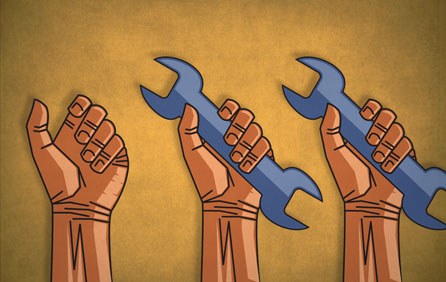Why it's Time to Unleash Manufacturing Innovation
Compared to service businesses, manufacturers are nearly 10 times stronger exporters; their employees contribute twice as much to national productivity as workers in other sectors; and each job inside a manufacturing facility can spur the creation of an additional three to five jobs outside it.
In countries around the world, manufacturing’s multiplier effect has gone to work – creating jobs, boosting productivity, fueling innovation, and balancing economies. In the United States, for example, manufacturing made the largest contribution to GDP growth of any sector in 2012 and has expanded for each of the past seven months. That is how the manufacturing renaissance is driving recovery today – and helping businesses and nations prosper for many tomorrows to come.
Advanced manufacturing is replacing smoke stacks and shuttered factories with high-tech laboratories and state-of-the-art plants. These new, 21st-century models for prototyping and innovating enable the manufacturing industry to generate up to 90 percent of business R&D spending.
Generations ago, companies like Dow created and marketed new products entirely on their own. Products like Saran Wrap and Ziploc Bags went from the lab bench to the factory floor entirely within our company. Today, the breakthroughs we seek – game-changing ideas like self-healing materials and self-driving cars – are so complex that they will never materialize if we all stay within the boundaries of our sectors or our companies.
Innovation does not – and cannot – happen in silos anymore. The best products and industries of tomorrow will be born at what I call “the intersections.”
That is why, more and more, we need to work to form partnerships to unlock progress. We need collaboration among the brightest minds in business, science, and engineering. In the same spirit, we need active collaboration between the public and private sectors as well.
For businesses to succeed – for economies to grow – governments must create the conditions for innovation ecosystems to develop and flourish. This requires renewed focus in three key areas.
First, human capital. Machines may do the heavy lifting on factory floors, but it is human beings – specifically, scientists, engineers, and other highly skilled professionals – who turn advanced manufacturing clusters into centers of innovation. Governments must do more to educate young people, whether in universities or through skills training at community colleges, and to retrain experienced workers – particularly in science, technology, engineering, and mathematics.
Second, the business climate. In countries like the United States, a complex environment of regulations and tax provisions determines if and where companies scale up and invest. Too often, these regulations add costs and, worse, uncertainty to these calculations.Forward-thinking countries are seeding the ground for manufacturing growth by shifting to smarter regulation. Through competitive tax rates, streamlined permitting processes and other reforms, these countries enable government to operate at the speed of business, increasing predictability for companies that are looking to invest.
Third, a smart, balanced energy policy. Manufacturers gravitate toward regions where energy is affordable and accessible – not merely because we consume energy, but also because we create so much more with it. We use natural gas, for example,as a feedstock – as the building block that transforms our innovations from ideas into reality.
More than 95 percent of the world’s synthetic materials would not be possible without our industry: from pharmaceuticals to smartphones to lighter, more efficient vehicles. When natural gas is used in the manufacturing process instead of burned or exported, it generates eight times more value across the economy.
In this way, advanced manufacturing expands economies when they are healthy and helps them recover when they are not. It creates competitiveness in a way no other sector can – encouraging countries to invest in their work forces, laying the groundwork for further innovation, and making far better use of natural resources.
But again, this virtuous cycle cannot set itself in motion. If we create an ecosystem in which innovators can work together – at the intersections between business, government, academia, and civil society – then the current manufacturing renaissance can become a revolution. Far from the so-called demise of manufacturing, we will instead see the rise of a new era of investment, innovation, job creation, and prosperity that will improve lives around the world.
Andrew Liveris is Chairman and CEO of Dow.
Original article can be read here: http://www.cnbc.com/id/101349128



Leave a Reply
Want to join the discussion?Feel free to contribute!